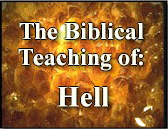

Page 3
By Ernest L. Martin, Ph. D., 1978
Edited by David Sielaff, June 2003
© 1976-2018 Associates for Scriptural Knowledge
The Three Biblical "Hells"
In the King James Version of the Bible, written in the early 1600s, the English word "hell" is used for three different Greek terms. Our English word originally came from the Anglo-Saxon word hel which meant a hidden place. We find this primitive meaning in our English word hole, a hole in the ground. If one dug a pit or a hole and put in it a coin and covered it up, the coin could be said to be in a hidden place — it would be in the Anglo-Saxon hel (or by extension hell). Obviously, there were never any fires associated with such holes or hells. The original "hells" were simply pits in the ground or their equivalents and nothing more.
Now let us look at how this early English word relates to the biblical "hells." The Anglo-Saxon hel represents an exact equivalent of the Hebrew sheol. The word sheol means "the unseen." It is rendered "the grave" 31 times in the Old Testament. The King James translation also represented it by the English "hell" 31 times (with the margin showing 4 times, "the grave"), and they made it "the pit" 3 times. In every case, the translation "grave (a hole in the ground) or a word describing "the state of death" would have been the best renderings and they would satisfy all contexts.
The Greek hades (the unseen) used in the New Testament has precisely the same meaning, in its original form, as the Hebrew sheol and the Anglo-Saxon hel. Though the Greeks finally adorned the primitive meaning of hades with many elaborations (and this is exhibited by their many mythological beliefs along with their own non-biblical ideas about the various stages of death), the New Testament writers associated the word hades with the Hebrew sheol.
In Acts 2:27, 31 Luke quotes Psalm 16:10 and renders the Hebrew sheol as hades. This equates hades with the simple Hebrew meaning of "the grave" or sometimes "the state of death." This fact is manifested in the death of Christ. When He died, the Old Testament prophesied that He would be placed in sheol (Psalm 16:10) or, as Luke said, in hades (Acts 2:27, 31). This hades was inside His physical tomb where His body lay for three days. Christ was dead for those three days because it is consistently shown in the New Testament that Christ was resurrected from the dead, not from among the living (1 Corinthians 15:20). 2 There were certainly no fires inside Christ’s tomb while He lay there dead for three days. His grave clothes were not scorched (John 20:6–7) nor did His body show any evidence of burns. The hades where Christ was, was simply "the grave" (or tomb), and that is what hades or sheol means.
In Luke 16:19–31, however, we do have a section of scripture which has the word hades associated with fire after the death of a person. The whole of the story is the parable of Lazarus and the Rich Man. The parable is entirely symbolic. 3
Gehenna Fire
The second word in the New Testament translated "hell" in the King James Version is Gehenna. This is a Greek transliteration of a geographical term signifying in the Old Testament the "Valley of Hinnom" (Joshua 15:8; 2 Chronicles 33:6). This valley surrounded the western and southern walls of Jerusalem. In the southeasterly part of this valley, the refuse of the city was burnt. This was the place in which some early Israelites burnt their children to the pagan god Moloch (2 Chronicles 28:3). An altar raised up for this purpose gave the name Tophet also to the area (Isaiah 30:33).
In the time of Christ the heathen idolatry had ceased in the Valley of Hinnom but there were still fires in the southeastern region for the burning of the city refuse. The prevailing winds in Jerusalem are normally from the west or northwest and burning the garbage in this area of Gehenna normally kept the nauseous smoke away from the main part of the city. This city dump for the destruction of the refuse from Jerusalem typically served as a sign of the divine destruction which could come through God’s fiery judgments (Jeremiah 7:31–32; 19:11–14).
The prophetic determinations of God often involve fire. This is because the sins of Jerusalem in the time of Jeremiah were so great, God said through the prophet that He would bring "unquenchable fires" upon the city,
"But if you will not hearken to Me to hallow the sabbath day, and not to bear a burden, even entering in at the gates of Jerusalem on the Sabbath day; then will I kindle a fire in the gates thereof, and it shall devour the palaces of Jerusalem, and it shall not be quenched."
• Jeremiah 17:27